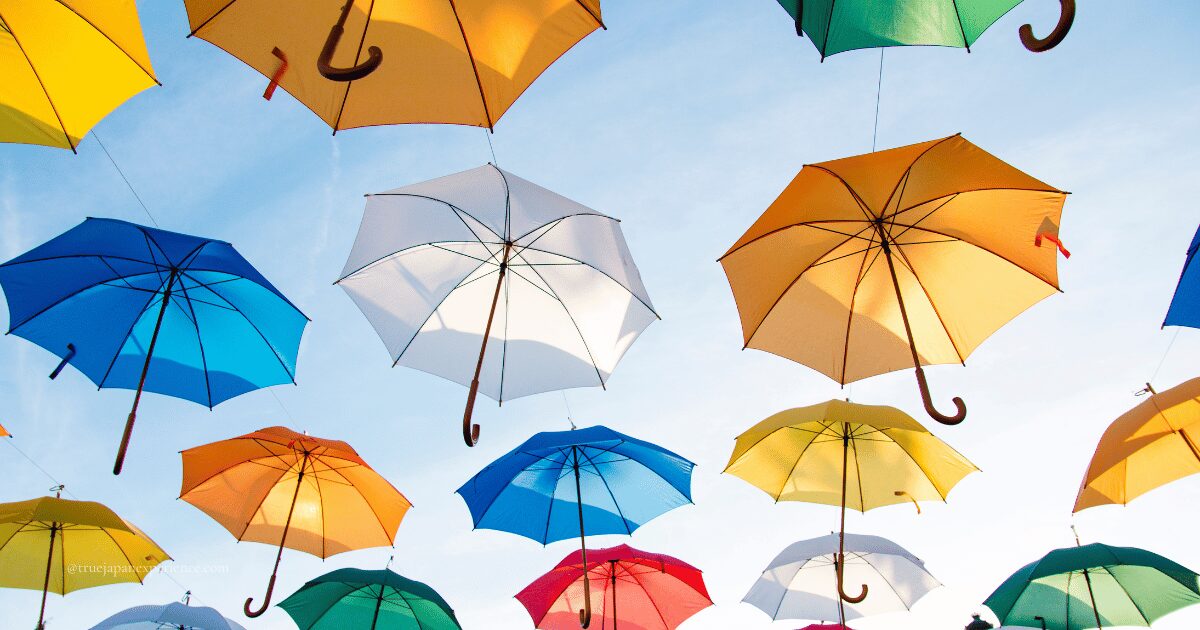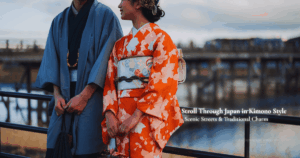Japanese umbrella culture may surprise many visitors.
In Japan, people use umbrellas even when there’s just a little rain—or no rain at all.
On sunny days, you’ll often see people carrying umbrellas to block the sun. This habit might seem strange, but for many in Japan, it’s normal. Umbrellas are not just for staying dry. They help people stay cool, protect their skin, and feel more comfortable outdoors.
Let’s take a closer look at why umbrellas play such an important role in daily life in Japan.
How Japanese Umbrella Culture Began

Japanese umbrella culture has its roots in a type of umbrella called wagasa.
These traditional umbrellas were introduced from China many centuries ago and became widely used in Japan from the Heian period.
Wagasa were made with bamboo frames and paper covers, and coated with oil to make them waterproof.
Today, wagasa are no longer used on the streets.
But they still appear in traditional arts, like kabuki theater or festivals. Their design is seen as elegant and symbolic, often matched with kimono or traditional clothing.
While the umbrella itself is not unique to Japan, wagasa helped shape the look and feeling of what we now call Japanese umbrella culture.
Japanese Umbrella Culture in Daily Life

Japanese umbrella culture is easy to see in daily life.
People often carry umbrellas, even if it might only rain a little. One reason is how easy it is to buy umbrellas in Japan.
Clear vinyl umbrellas are sold at almost every convenience store. They are cheap, lightweight, and see-through, so people can walk safely, even in busy places.
Because of this, some people don’t carry their own umbrellas—they simply buy one when it starts to rain. While this habit may seem strange, it shows how much people care about staying dry and being ready. In Japan, having an umbrella is part of being well-prepared.
In recent years, many people have started using dual-purpose umbrellas that work for both rain and sun. These are called hare-ame ken’yō-gasa in Japanese, or “rain-and-sun umbrellas.”
These umbrellas are different from regular rain umbrellas.
They are made mainly to block sunlight and protect the skin from UV rays. At the same time, they have water-repellent or waterproof coating, so they can also be used in light rain or sudden showers. This makes them very practical for Japan’s changing weather.
There are two types:
晴雨兼用傘 (hare-ame): sun umbrellas with extra protection for rain
雨晴兼用傘 (ame-hare): rain umbrellas with added UV protection
晴雨兼用傘 are often lighter and made with UV-cut and heat-blocking fabric. On the other hand, 雨晴兼用傘 focus more on rain but may offer less protection from the sun. Knowing the difference can help you choose the best one for your needs.
Using one umbrella that works in both rain and sun is not only smart—it’s part of Japanese umbrella culture. It shows how umbrellas are used not just to stay dry, but also to stay healthy and comfortable all year round.
Using Umbrellas on Sunny Days

Another special part of Japanese umbrella culture is how often people use umbrellas even when it’s sunny.
This habit is especially common during Japan’s hot and humid summer.
On sunny days, the heat can feel intense. The strong UV rays and high humidity make walking outside tiring—and even dangerous. That’s why many people use sun umbrellas (higasa) to stay cool and protect their skin.
Using a sun umbrella helps:
・Avoid sunburn
・Lower body temperature
・Reduce the risk of heatstroke
It’s not only about comfort. The Japanese government also recommends using sun umbrellas as part of heat safety during summer months.
So when you visit Japan in summer, don’t be surprised if you see people walking under umbrellas—even without a single cloud in the sky.
It’s a smart and healthy part of daily life.
Not Just for Women: Sun Umbrellas for Everyone
Japanese umbrella culture is also changing with the times.
In the past, sun umbrellas were mostly used by women. But today, more men are carrying them too.
This change comes from a new awareness about health and skin care.
Many men want to avoid sunburn and stay cool, especially in summer. Some choose stylish umbrellas that match their clothes. Others just want to be comfortable and safe in the heat.
Using a sun umbrella is now seen as smart, not strange. It’s part of a new way of thinking—and part of modern Japanese umbrella culture.
How Often Umbrellas Are Used in Japan

How Often Umbrellas Are Used in Japan
Japan stands out in the world when it comes to umbrella use.
People don’t just carry them on rainy days—they use umbrellas more often, even in light rain or sunshine. And the numbers prove it.
In one survey of 35 countries, Japan ranked first in the number of umbrellas owned per person—3.3 umbrellas, compared to the global average of 2.4. Interestingly, Japan was only 13th in the number of rainy days per year.
This suggests that people carry and prepare umbrellas even when rain is light or uncertain.
The same study showed that 62% of umbrella users in Japan use regular long umbrellas, while the global average is much lower. Around 55% of people worldwide prefer foldable umbrellas.
This makes Japan stand out as one of the few countries where long umbrellas are more common than compact ones.
As for sun umbrellas, the numbers are also high. Around 47.4% of people in Japan use them, and use is growing, especially among younger people. Even among men, 1 in 4 now say they use sun umbrellas on sunny days.
Together, these facts show that Japanese umbrella culture is not just about rain. It’s a habit, a preparation, and even a sign of self-care. Whether it’s light drizzle or bright sunshine, many Japanese people are ready with an umbrella in hand.
Why Japanese People Use Umbrellas So Often

Why do people in Japan use umbrellas so much—sometimes even when it’s barely raining?
One reason is the climate. Japan has a long rainy season, sudden afternoon showers in summer, and very high humidity. When people get wet, it’s hard to dry off quickly. That’s why even a little rain is enough to make people open an umbrella.
Also, in many Japanese cities, people walk a lot and use public transportation. If you’re walking to the train station or waiting at a bus stop, an umbrella becomes a daily necessity.
Another reason is convenience. Cheap, clear plastic umbrellas are sold at almost every convenience store. You can buy one anytime, which makes using an umbrella an easy choice.
Finally, there’s a cultural side.
In Japan, being prepared is seen as polite and responsible. If you get wet because you didn’t bring an umbrella, some might see it as careless or unprepared.
Final Thoughts

When you visit Japan, take a moment to notice how people use umbrellas.
Whether it’s raining hard, just drizzling, or even sunny, you’ll see umbrellas everywhere—clear vinyl ones, stylish sun umbrellas, or those made for both rain and shine.
In Japan, carrying an umbrella isn’t anything special.
It’s just part of everyday life.
Want to learn more about everyday customs in Japan?
Check out our Japanese Culture Tips for more insights into how people live, travel, and stay comfortable across the seasons.









